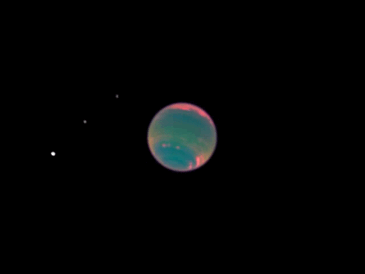Curiosity Looks For Damage To Its Wheels.

Curiosity looks for damage to its wheels.
Source
More Posts from Maevetheeuropan and Others
The Five W’s of an Expandable Habitat in Space
Who: In this case, it’s really a “what.” The Bigelow Expandable Activity Module (BEAM) is an expandable module developed by Bigelow Aerospace using a NASA patent conceptualized in the 1990s. It is made up of layers of fabric that will expand when installed and equalize with the pressure of the International Space Station.

What: Sensors inside BEAM will monitor temperature and radiation changes, as well as its resistance to potential orbital debris impacts. During its time on station, the airlock between BEAM and the rest of the space station will remained closed, and astronauts will enter only to collect data and help the experiment progress. If BEAM is punctured, the habitat is designed to slowly compress to keep the rest of the space station safe.
With the BEAM launch, deployment and time on station, Bigelow will demonstrate a number of expandable habitat capabilities, such as its folding and packing techniques, radiation protection capability and its thermal, structural and mechanical durability.

When: BEAM is set to launch on SpaceX’s eighth Dragon resupply mission April 8, and will be docked to the space station for a minimum two-year demonstration period.
Where: The International Space Station’s mechanical arm will transport BEAM from the spacecraft to a berthing port on the Tranquility module where it will then be expanded.

Why: These expandable modules take up less room on a rocket, but once set up, provide more volume for living and working in space.

When we’re traveling to Mars or beyond, astronauts need habitats that are both durable and easy to transport and to set up. That’s where expandable technology comes in. BEAM is one of the first steps to test expandable structures as a viable alternative to traditional space habitats.
Make sure to follow us on Tumblr for your regular dose of space: http://nasa.tumblr.com
ooooo how awesome!

Prototype of Space Station’s Advanced Plant Habitat via NASA http://ift.tt/2fremIw

Neptune and its moons (Proteus, Larissa, Despina and Galatea)
Credit: NASA / Hubble (infrared)

Mega-tsunamis in an ancient ocean on Mars may have shaped the landscape and left deposits that hint at whether the planet was once habitable, researchers say.
The giant waves, thought to have reached up to 120 metres in height as they raced over the land, could have been triggered by two large meteorites slamming into the surface.
The tsunamis may been powerful enough to shape much of the ancient coastlines on Mars, said J. Alexis Palmero Rodriguez, of the Planetary Science Institute in Tucson, Arizona, who led the study.
Writing in the journal Scientific Reports, the international team, which included scientists from the US, China and Germany, describe how they set out to probe a Martian mystery.
It has previously been proposed that the lowlands of the northern hemisphere of Mars were catastrophically flooded around 3.4 billion years ago, forming a vast ocean, potentially covering several million square kilometres. But scientists have been puzzled by the lack of an associated shoreline and its expected features.
Now Rodriguez and his team think they may have the answer- the fact that it is hard to make out such ancient shorelines is because huge tsunamis buried them, depositing sediments up to hundreds of kilometres inland.
Continue Reading.

NASA Wants Deep Space Habitat Ideas
How will humans live on Mars? Well, NASA’s not really sure yet, but if you’ve got any ideas you can submit them now. The agency has just put out a call for proposals for “deep space habitation prototypes.”
from NASA’s press release:
NASA is soliciting proposals for the development of prototypes for deep space habitats that will give astronauts a place to call home during long-duration missions supporting the agency’s Journey to Mars.
lol sometimes science publications are like 20 pages of gibberish. It feels like an alien language I’m learning slowly as I stare at the pages…
—___—

That looks pretty damn cool.
(via The World’s First ‘Marschitect’ Is Laying the Groundwork for Architecture in Space — How We Get To Next)

GUYS https://twitter.com/AltNatParkSer/status/824054953404669953 http://www.scientistsmarchonwashington.com/ THE NATIONAL PARK SERVICE IS IN OPEN REBELLION

Fantastic success story for the astronomy community of China, congratulations!
-
 maevetheeuropan reblogged this · 8 years ago
maevetheeuropan reblogged this · 8 years ago -
 betsyplummer-blog liked this · 8 years ago
betsyplummer-blog liked this · 8 years ago -
 bradleythecallum reblogged this · 8 years ago
bradleythecallum reblogged this · 8 years ago -
 linkinm1 liked this · 8 years ago
linkinm1 liked this · 8 years ago -
 luisdaniel91-blog liked this · 9 years ago
luisdaniel91-blog liked this · 9 years ago -
 alltimeepic liked this · 9 years ago
alltimeepic liked this · 9 years ago -
 claraxbarton liked this · 9 years ago
claraxbarton liked this · 9 years ago -
 maevemauvaise reblogged this · 9 years ago
maevemauvaise reblogged this · 9 years ago -
 maevemauvaise liked this · 9 years ago
maevemauvaise liked this · 9 years ago -
 weirdautumngarden reblogged this · 9 years ago
weirdautumngarden reblogged this · 9 years ago -
 thecaptainspacepirate reblogged this · 9 years ago
thecaptainspacepirate reblogged this · 9 years ago -
 comfortablyblind liked this · 9 years ago
comfortablyblind liked this · 9 years ago -
 teammagmasgroudon-blog liked this · 9 years ago
teammagmasgroudon-blog liked this · 9 years ago -
 kiefgoblin liked this · 9 years ago
kiefgoblin liked this · 9 years ago -
 sonianevermindsss-blog liked this · 9 years ago
sonianevermindsss-blog liked this · 9 years ago -
 idk-what-to-do liked this · 9 years ago
idk-what-to-do liked this · 9 years ago -
 dearkurisu liked this · 9 years ago
dearkurisu liked this · 9 years ago -
 chewingchewychewinggum liked this · 9 years ago
chewingchewychewinggum liked this · 9 years ago -
 spacefangasm reblogged this · 9 years ago
spacefangasm reblogged this · 9 years ago -
 superchair reblogged this · 9 years ago
superchair reblogged this · 9 years ago -
 junryou liked this · 9 years ago
junryou liked this · 9 years ago -
 goldpilot22 liked this · 9 years ago
goldpilot22 liked this · 9 years ago -
 captainjzh reblogged this · 9 years ago
captainjzh reblogged this · 9 years ago -
 captainjzh liked this · 9 years ago
captainjzh liked this · 9 years ago -
 william-richard-no-s liked this · 9 years ago
william-richard-no-s liked this · 9 years ago -
 mysticalgalaxysalad liked this · 9 years ago
mysticalgalaxysalad liked this · 9 years ago -
 hyperwave liked this · 9 years ago
hyperwave liked this · 9 years ago -
 spaaaaaceblog reblogged this · 9 years ago
spaaaaaceblog reblogged this · 9 years ago
